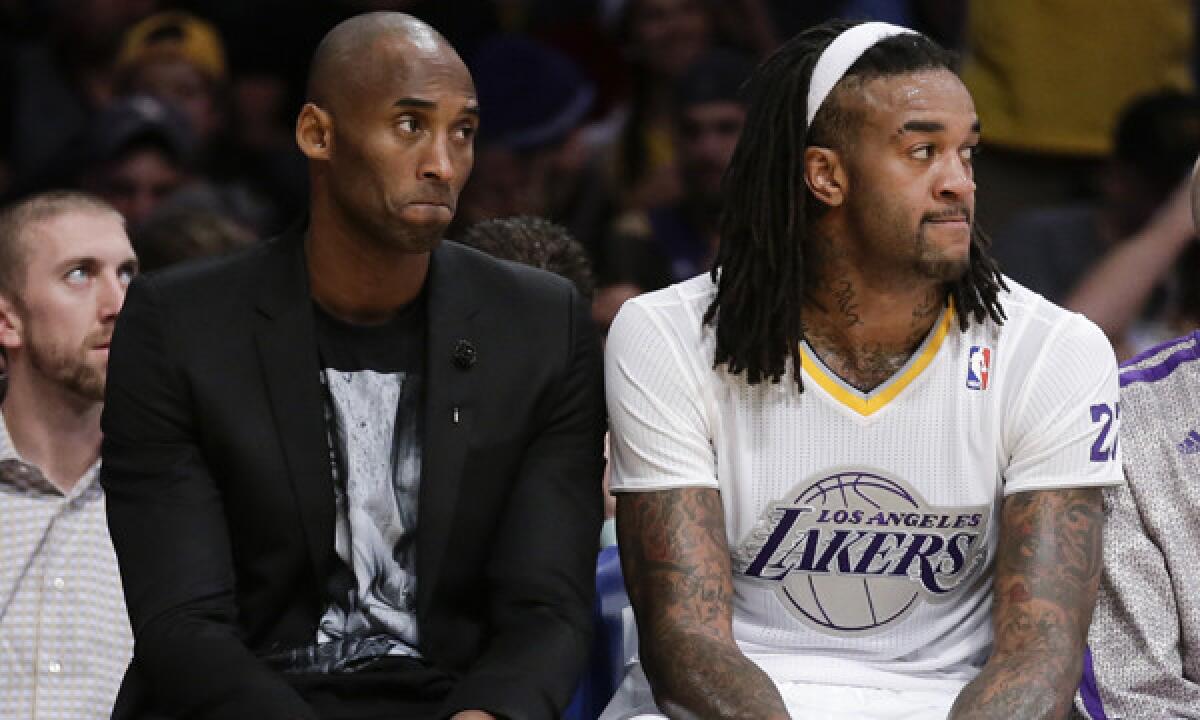Lakers are falling in standings and in television ratings

- Share via
Magic Johnson apparently isn’t the only one who thinks the Lakers are unwatchable.
The Lakers’ ratings on Time Warner Cable SportsNet declined 37.5% over the team’s first 40 games versus the same period last season, according to Nielsen ratings in the Los Angeles market.
Lakers games averaged a 2.72 rating over those games, down from a 4.35 last season, TWC’s first as the team’s broadcast partner.
“I wouldn’t be overly concerned about it, but I certainly would keep an eye on it,” said David Carter, executive director of the USC Sports Business Institute. “That kind of precipitous drop, if it becomes something where they have that drop and then they never recover from it, that’s certainly a real problem.”
The Clippers’ TV ratings also have dipped this season, though not as sharply. The team’s average rating of 1.28 on Prime Ticket in L.A. for the first 40 games was down 14.7% from the 1.5 rating at the same point last season.
The ratings gap between the Lakers and the Clippers this season is the lowest since at least the 1999-2000 season.
“Although the TWC ratings are down, we know that Lakers fans continue to have an appetite for Lakers programming, be it live games, classic games or original programming,” Lakers spokesman John Black said. “We’ve seen similar ratings patterns in past Lakers seasons, and while we do see a dip this season, my understanding is that we’re still outperforming the marketplace.
“We all know that we can’t be championship contenders every year, but there is still an enormous base of Lakers fans who are following this team.”
The star power of the Lakers’ Kobe Bryant and the Clippers’ Chris Paul — and their absence — has also been reflected in the ratings.
In the six games Bryant has played this season, the Lakers averaged a 3.57 rating on TWC in the Los Angeles market. In the games Paul played on Prime before sustaining a separated shoulder last month, the Clippers averaged a 1.39 rating in the same market.
The injury-ravaged Lakers (16-30) have lost 17 of 20 games to fall into 14th place in the Western Conference.
There hasn’t been much allure to a team that has played without Bryant and Steve Nash for most of the season; Nash has played only six games because of nerve problems in his back. He could return next week but Bryant may be sidelined until March with lingering soreness and swelling in his fractured left knee.
The Lakers’ struggles have resulted in the team’s first non-sellout at Staples Center since December 2006 and prompted ESPN and TNT, in consultation with the NBA, to each drop a Lakers game they had planned to nationally televise earlier this month.
“We’ve always felt like the Lakers had tremendous goodwill and the equity in the bank that continues to draw the fans in season in, season out, win or lose,” said Paul Swangard, managing director of the Warsaw Sports Marketing Center at the University of Oregon, “so it’s interesting where this year everything has seemingly gone wrong how much of an eyeball exodus there has been from the TV product.”
The Lakers’ critics have included Johnson, the Hall of Fame point guard who won five championships in 13 seasons with the team. Johnson has ripped owner Jim Buss and Coach Mike D’Antoni, saying he “can’t stand to watch the Lakers play” because they are repeatedly beaten by teams on defense.
TWC executives obviously were hoping for higher ratings when they agreed to a 25-year, $5-billion deal with the Lakers that has made the team the envy of small-market competitors. Forbes recently reported that the Lakers’ $122-million take last season from TWC represented more than 20 times what the Charlotte Bobcats and Milwaukee Bucks received from their broadcast partners.
Meanwhile, the Clippers’ ratings decline seems puzzling given the team has a 33-15 record and is atop the Pacific Division. Even without Paul, the Clippers play what is widely regarded as an entertaining brand of basketball with acrobatic leapers Blake Griffin and DeAndre Jordan.
Clippers spokesman Seth Burton attributed his team’s ratings drop to several factors, including more early East Coast starts than usual at this point in the season and a handful of games being televised both locally and nationally. Burton said the Clippers’ ratings still rank as the third-highest since Prime Ticket started its partnership with the team during the 1996-97 season and noted that ratings typically climb in the second half of the season.
“We’re very happy with where we are,” Burton said, “and we’re confident in where we’re headed.”
Thomas Boyd, dean of the school of business and management at Kaplan University and a former sports marketing professor at Cal State Fullerton, said the Clippers’ drop could indicate “a behavioral change among fans.”
“Because both teams are down, even the Clippers during a strong year,” Boyd said, “I think it indicates some larger trend may be at work. It is too early to say that the ratings cannot recover, but the news should be of concern to them.”
Twitter: @latbbolch
More to Read
All things Lakers, all the time.
Get all the Lakers news you need in Dan Woike's weekly newsletter.
You may occasionally receive promotional content from the Los Angeles Times.







